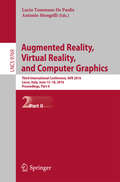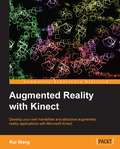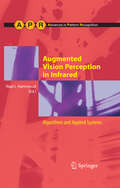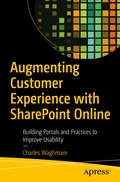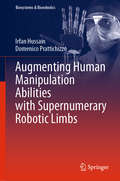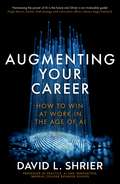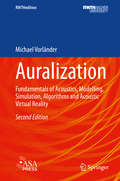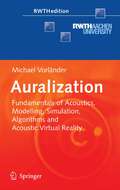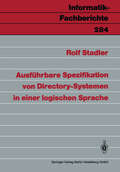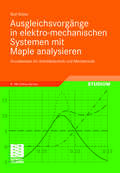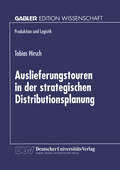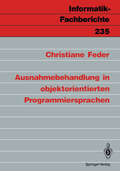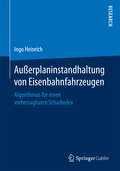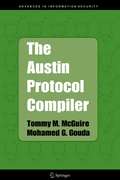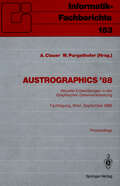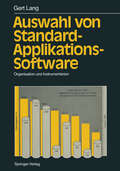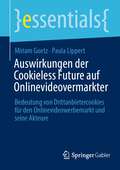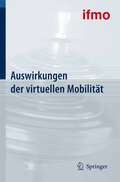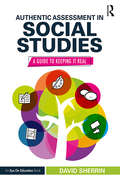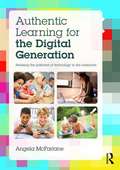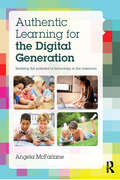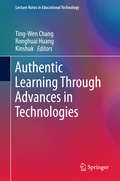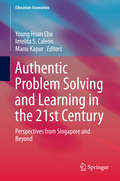- Table View
- List View
Augmented Reality, Virtual Reality, and Computer Graphics: Third International Conference, AVR 2016, Lecce, Italy, June 15-18, 2016. Proceedings, Part II (Lecture Notes in Computer Science #9769)
by Lucio Tommaso De Paolis Antonio MongelliThe 2-volume set LNCS 9768 and 9769 constitutes the refereed proceedings of the Third International Conference on Augmented Reality, Virtual Reality and Computer Graphics, AVR 2016, held in Lecce, Italy, in June 2016.The 40 full papers and 29 short papers presented werde carefully reviewed and selected from 131 submissions. The SALENTO AVR 2016 conference intended to bring together researchers, scientists, and practitioners to discuss key issues, approaches, ideas, open problems, innovative applications and trends on virtual and augmented reality, 3D visualization and computer graphics in the areas of medicine, cultural heritage, arts, education, entertainment, industrial andmilitary sectors.
Augmented Reality with Kinect
by Rui WangThis book is a mini tutorial with plenty of code examples and strategies to give you many options when building your own applications.This book is meant for readers who are familiar with C/C++ programming and want to write simple programs with Kinect. The standard template library can also be used as it is simple enough to understand.
Augmented Vision Perception in Infrared: Algorithms and Applied Systems (Advances in Computer Vision and Pattern Recognition)
by Riad I. HammoudThroughout much of machine vision’s early years the infrared imagery has suffered from return on investment despite its advantages over visual counterparts. Recently, the ?scal momentum has switched in favor of both manufacturers and practitioners of infrared technology as a result of today’s rising security and safety challenges and advances in thermographic sensors and their continuous drop in costs. This yielded a great impetus in achieving ever better performance in remote surveillance, object recognition, guidance, noncontact medical measurements, and more. The purpose of this book is to draw attention to recent successful efforts made on merging computer vision applications (nonmilitary only) and nonvisual imagery, as well as to ?ll in the need in the literature for an up-to-date convenient reference on machine vision and infrared technologies. Augmented Perception in Infrared provides a comprehensive review of recent deployment of infrared sensors in modern applications of computer vision, along with in-depth description of the world’s best machine vision algorithms and intel- gent analytics. Its topics encompass many disciplines of machine vision, including remote sensing, automatic target detection and recognition, background modeling and image segmentation, object tracking, face and facial expression recognition, - variant shape characterization, disparate sensors fusion, noncontact physiological measurements, night vision, and target classi?cation. Its application scope includes homeland security, public transportation, surveillance, medical, and military. Mo- over, this book emphasizes the merging of the aforementioned machine perception applications and nonvisual imaging in intensi?ed, near infrared, thermal infrared, laser, polarimetric, and hyperspectral bands.
Augmenting Customer Experience with SharePoint Online: Building Portals and Practices to Improve Usability
by Charles WaghmareBuild, enrich, and transform customer experience using SharePoint Online. This book will discuss different SharePoint Online approaches that you can use to enhance customer experience, including digital portals, enterprise content management, Microsoft Teams and much more. Augmenting Customer Experience with SharePoint Online starts with an introduction to SharePoint Online features you can adopt to create better digital customer experience and transformation. Next, you will learn about augmentation for user and customer experience followed by guidelines and methods to develop smart and intelligent portals. Moving forward, you will cover enterprise and web content management in detail along with the challenges and benefits of using SharePoint Online. The partner ecosystem is discussed next with a detailed discussion on working with suppliers, partners, and vendors. Along the way, you will see how to create smart solutions using SharePoint Online and how to manage customer references. Finally, you will go through the use of SharePoint Online in different business sectors with the help of case studies. After reading the book, you will be able to adopt SharePoint Online features to augment customer and user experience. What You Will Learn Augment customer experience Create smart and intelligent portals for various business needs Efficiently manage enterprise and web content Enhance your partner ecosystem for better collaboration Build SharePoint Online solutions Who This Book Is For Anyone wanting to adopt SharePoint Online to develop portals, content management systems, knowledge hubs, reference captures, or online foundries.
Augmenting Human Manipulation Abilities with Supernumerary Robotic Limbs (Biosystems & Biorobotics #26)
by Irfan Hussain Domenico PrattichizzoThis book offers a timely report on an emerging topic in the field of wearable assistive technology: the design and development of robotic extra fingers. After a concise review of the state of the art and a description of earlier prototypes, it discusses the authors’ efforts to address issues such as portability and wearability of the devices, including strategies to reduce fatigue and to integrate the motion of the extra fingers with that of the human hand. The book also explores optimized control algorithms and the design of wearable sensorimotor interfaces, and presents a set of tests carried out on healthy subjects and chronic stroke patients. Merging concepts from robotics, biomechanics, human factors and control theory and offering an overview of supernumerary robotic fingers, including the challenges, this book will inspire researchers involved in the development of wearable robotic devices and interfaces based on the principles of wearability, safety, ergonomics and user comfort.
Augmenting Your Career: How to Win at Work In the Age of AI
by David ShrierEssential reading for anyone who wants to be relevant in the workforce of tomorrow.Drawing on more than a decade of research on artificial intelligence and human systems, David L. Shrier, a globally recognised futurist and innovation specialist, delivers fascinating insights and tips on how to win at work in the age of AI. Artificial intelligence is driving workforce disruption on a scale not seen since the Industrial Revolution. Automation was once associated with mass layoffs in heavy industry like auto and steel, but computers are getting smarter and are beginning to replace traditionally 'white collar' roles like law, consulting, banking and finance.Yet some curious findings are emerging from the world's leading research labs. The combined intellect of people and machines working in harmony is able to achieve outcomes that are better than either can accomplish alone. Properly tuned AI systems can even help harness the power of the collective intelligence of an entire organisation or community to predict future events. This isn't science fiction; this is science fact the author personally helped discover.What are these new hybrid AI+people systems? What can specialised AI systems do to help you succeed in your career? How can you work most effectively with these machines?Written by a practitioner who has worked with some of the largest companies in the world as well as some of the most innovative startups, Augmenting Your Career provides a rare window into a frontier area of computer science that will change everything about how you work and what your job will look like. Read this book and fast track your evolution to the knowledge worker of the future.
Auralization: Fundamentals of Acoustics, Modelling, Simulation, Algorithms and Acoustic Virtual Reality (RWTHedition)
by Michael VorländerAuralization is the technique of creation and reproduction of sound on the basis of computer data. With this tool it is possible to predict the character of sound signals which are generated at the source and modified by reinforcement, propagation and transmission in systems such as rooms, buildings, vehicles or other technical devices. This book is organized as a comprehensive collection of the basics of sound and vibration, acoustic modelling, simulation, signal processing and audio reproduction. With some mathematical prerequisites, the readers will be able to follow the main strategy of auralization easily and work out their own implementations of auralization in various fields of application in architectural acoustics, acoustic engineering, sound design and virtual reality. For readers interested in basic research, the technique of auralization may be useful to create sound stimuli for specific investigations in linguistic, medical, neurological and psychological research, and in the field of human-machine interaction.
Auralization: Fundamentals of Acoustics, Modelling, Simulation, Algorithms and Acoustic Virtual Reality (RWTHedition)
by Michael VorländerThis is the first focused and detailed textbook on acoustic virtual reality. Auralization is the creation of audible acoustic sceneries from computer-generated data. The term "auralization" is to be understood as being analogue to the well-known technique of "visualization". In visual illustration of scenes, data or any other meaningful information, in movie animation and in computer graphics, we describe the process of "making visible" as visualization. In acoustics, auralization is taking place when acoustic effects, primary sound signals or means of sound reinforcement or sound transmission, are processed to be presented by using electro-acoustic equipment. This book is organized as a comprehensive collection of basics, methodology and strategies of acoustic simulation and auralization.
Ausführbare Spezifikation von Directory-Systemen in einer logischen Sprache (Informatik-Fachberichte #284)
by Rolf StadlerDas Buch behandelt die Spezifikation von Directory-Systemen unter Anwendung von Konzepten der logischen Programmierung. Ausgehend von der Definition derArchitektur eines Directory-Systems wird eine Spezifikationsmethode zur Beschreibung solcher Architekturen vorgestellt. Als Spezifikationssprache dient die Sprache der Hornklausel-Logik, erweitert um Negation. Im Buch werden eine von D.B. Terry bei Xerox PARC entworfene Architektur und ein Ausschnitt aus der Architektur des internationalen Standards f}r Directory-Systeme (X.500) spezifiziert. Daran lassen sich die Vorteile der vorgeschlagenen Methode aufzeigen: Die Spezifikationen sind kompakt, gut lesbar und besitzen eine deklarative und eine prozedurale Semantik. Die erstellten Spezifikationen lassen sich auf einem Prolog-System ausf}hren. Die Ausf}hrbarkeit der Spezifikationen erweist sich als vielseitig anwendbare Eigenschaft, welche beispielsweise die Simulation eines Directory-Systems bei gegebener Konfiguration erm|glicht oder die ]berpr}fung (Verifikation, Validierung) einer Spezifikation erleichtert.
Ausgleichsvorgänge in elektro-mechanischen Systemen mit Maple analysieren: Grundwissen für Antriebstechnik und Mechatronik
by Rolf MüllerDas Buch vermittelt Grundlagen der Modellierung, Analyse und Simulation elektromechanischer Systeme unter Verwendung des Computeralgebra-Systems Maple. Am Anfang werden die für die Arbeit mit Maple notwendigen Befehle in konzentrierter Form anhand von einfachen Beispielen vorgestellt. Ausführlich wird danach auf das Lösen von Differentialgleichungen und Differentialgleichungssystemen mit Maple eingegangen. Das Vorgehen bei der Ermittlung analytischer und numerischer Lösungen wird beschrieben und an zahlreichen Beispielen erläutert.
Auslieferungstouren in der strategischen Distributionsplanung (Produktion und Logistik)
by Tobias HirschTobias Hirsch entwickelt ein heuristisches Verfahren, das die Auswirkungen von Standortentscheidungen auf die Tourenkosten bei täglich wechselnder Auftragssituation abschätzt. Die Leistungsfähigkeit des Verfahrens wird an Praxisbeispielen verdeutlicht.
Ausnahmebehandlung in objektorientierten Programmiersprachen (Informatik-Fachberichte #235)
by Christiane FederDie Ausnahmebehandlung ist ein vor allem bei der Automatisierung technischer Prozeßsysteme eingesetztes Sprachmittel. Trotz vieler Entwurfs- und Implementierungsvorschläge für Ausnahmemechanismen blieben die formalen Aspekte der Ausnahmebehandlung bisher weitgehend unberücksichtigt. In diesem Buch wird eine neue Theorie der Ausnahmebehandlung vorgestellt. Für die formale Beschreibung setzt die Autorin die denotationelle Methode der Semantikdefinition ein. Damit kann insbesondere die Einflußnahme der Ausnahmebehandlung auf die Ablaufsteuerung eines Programms, also die wichtigste Auswirkung von Ausnahmemechanismen, sehr elegant, präzise und übersichtlich dargestellt werden. Das Buch wendet sich an Leser, die sich über die Möglichkeiten der Ausnahmebehandlung informieren, Programmiersprachen um einen konkreten Ausnahmemechanismus erweitern oder bestehende Mechanismen vergleichen wollen. Das Ausnahmekonzept wird verständlich und nachvollziehbar dargestellt, ohne daß auf die notwendigen Formalismen verzichtet werden muß. Dabei werden auch die zum Verständnis nötigen Konzepte und Begriffe der objektorientierten Programmierung und der denotationellen Semantikbeschreibung eingeführt.
Außerplaninstandhaltung von Eisenbahnfahrzeugen: Algorithmus für einen vorhersagbaren Schadindex
by Ingo HeinrichIngo Heinrich untersucht die außerplanmäßige Instandhaltung und beschreibt die methodische Herleitung eines mathematischen Modells, um den Grad der Schädigung einer Flotte von Eisenbahnfahrzeugen in eine valide Korrelation mit vorhandenen betrieblichen Ressourcen zu bringen. Diese Wechselbeziehung wird in einen Schadindex überführt und mittels eines Prognosemodells in seinem zeitlichen Verlauf vorhersagbar dargestellt. Die Prognose berücksichtigt auch die Möglichkeit zur iterativen Anpassung, beispielsweise das zukünftige Schädigungsverhalten in Abhängigkeit einer veränderten Fahrzeugzahl oder einer Umstellung der Mitarbeiterbesetztzeiten in den Instandhaltungswerken. Damit erhalten Eisenbahnver-kehrsunternehmen mehr Handlungsspielräume zur Verfolgung ihrer strategischen und wirtschaftlichen Ziele.
The Austin Protocol Compiler (Advances in Information Security #13)
by Tommy M. McGuire Mohamed G. GoudaThere are two groups of researchers who are interested in designing network protocols and who cannot (yet) effectively communicate with one another c- cerning these protocols. The first is the group of protocol verifiers, and the second is the group of protocol implementors. The main reason for the lack of effective communication between these two groups is that these groups use languages with quite different semantics to specify network protocols. On one hand, the protocol verifiers use specification languages whose semantics are abstract, coarse-grained, and with large atom- ity. Clearly, protocol specifications that are developed based on such semantics are easier to prove correct. On the other hand, the protocol implementors use specification languages whose semantics are concrete, fine-grained, and with small atomicity. Protocol specifications that are developed based on such - mantics are easier to implement using system programming languages such as C, C++, and Java. To help in closing this communication gap between the group of protocol verifiers and the group of protocol implementors, we present in this monograph a protocol specification language called the Timed Abstract Protocol (or TAP, for short) notation. This notation is greatly influenced by the Abstract Protocol Notation in the textbook Elements of Network Protocol Design, written by the second author, Mohamed G. Gouda. The TAP notation has two types of sem- tics: an abstract semantics that appeals to the protocol verifiers and a concrete semantics thatappeals to the protocol implementors group.
Austrographics ’88: Aktuelle Entwicklungen in der Graphischen Datenverarbeitung Fachtagung, Wien, 28.–30. September 1988 (Informatik-Fachberichte #183)
by Alexander Clauer Werner PurgathoferDieser Band enthält die Beiträge zur AUSTROGRAPHICS '88, einer in zweijährigem Turnus durchgeführten deutschsprachigen Tagung über Graphische Datenverarbeitung. Die Tagung fand vom 28. bis 30. September 1988 an der Technischen Universität Wien statt. Mit Rücksicht auf das in der gleichen Woche ebenfalls in Wien veranstaltete GI-Fachgespräch zum Thema Visualisierungstechniken und Algorithmen (Informatik-Fachberichte Band 182) liegen die Akzente der AUSTROGRAPHICS '88 diesmal auf anderen Gebieten. Nach einem Kapitel über neue Algorithmen der Graphischen Datenverarbeitung folgen Beiträge zu den Themenkreisen Graphische Benutzerschnittstellen, Kartographie, Hardware und Netze. Einen regelrechten Schwerpunkt bilden die Kapitel Freiformflächen und Geometrische Algorithmen.
Auswahl von Standard-Applikations-Software: Organisation und Instrumentarien
by Gert LangDas vorliegende Buch ist ein Wegweiser zur Auswahl von Standard-Applikations-Software. Ausgehend von ersten Überlegungen zum Einsatz von Standard-Software bis zur konkreten Entscheidung für ein Standard-Software-Produkt, erhält der Leser für alle Phasen dieses Auswahl- und Entscheidungsprozesses wichtige Orientierungshilfen, konkrete Werkzeuge und praktische Fallbeispiele an die Hand. Die vorgestellten Werkzeuge, wie z.B. die "Standardstrukturpläne", wurden in einem komplexen Projekt zur Software-Auswahl in einem Großunternehmen des Maschinen- bzw. Fahrzeugbaus entwickelt, da geeignete Instrumentarien für diese Aufgabe bisher nicht am Markt verfügbar sind. Die Lektüre des Fachbuches bringt für das Management das notwendige Verständnis für die Problematik eines solchen Projektes und für die mit der Durchführung des Projektes Beauftragten das Rüstzeug für eine konsequente wirtschaftliche und reproduzierbare Software-Auswahl. Die Software-Auswahl wird nicht als isolierte Aufgabe beschrieben, sondern eingebettet in den Rahmen Informationslogistik/CIM/Organisationsentwicklung; das Buch ist deshalb auch für Beratungsunternehmen, Software-Häuser und betriebswirtschaftliche Praktiker sowie Studenten interessant.
Auswirkungen der Cookieless Future auf Onlinevideovermarkter: Bedeutung von Drittanbietercookies für den Onlinevideowerbemarkt und seine Akteure (essentials)
by Miriam Goetz Paula LippertDrittanbietercookies ermöglichen Vermarktern eine fundierte Kampagnenanalyse und Zielgruppenbestimmung. Welche Auswirkungen hat der Wegfall von Cookies auf sie? Das essential beschreibt zunächst Cookies und deren aktuelle Einsatzfelder. Auf Basis von Experteninterviews mit Branchenkennern folgt dann ein Ausblick, welche Chancen und Risiken mit dem Wegfall der Cookies für die Vermarkterbranche und Endverbraucher einhergehen und welche Alternativen zu Drittanbietercookies existieren.
Authentic Assessment in Social Studies: A Guide to Keeping it Real
by David SherrinThis engaging book will show you how to move beyond tests and essay writing to implement authentic assessments in your middle or high school social studies classroom. Award-winning teacher David Sherrin explains the value of authentic assessments and offers practical ways to get started and dive deeper in your own practice. You&’ll be encouraged and inspired by the real-life stories of classroom successes and failures that illustrate the points throughout the book. The chapters cover a range of categories, including different types of written, creative, and civic action assessments. The book includes: planning charts and rubrics showing how to use, grade, and give feedback on assessments so they truly aid student learning and progress specific examples, useful tips, and ready-to-go instructions that you can use immediately with your class open-ended assessments encourage scaffolding or adaptation for individual or group work to fit your classroom needs You will learn how to personalize instruction and provide students with avenues for creativity and the types of learning experiences they need to be prepared for a complex world.
Authentic Assessment in Social Studies: A Guide to Keeping it Real
by David SherrinThis engaging book will show you how to move beyond tests and essay writing to implement authentic assessments in your middle or high school social studies classroom. Award-winning teacher David Sherrin explains the value of authentic assessments and offers practical ways to get started and dive deeper in your own practice. You&’ll be encouraged and inspired by the real-life stories of classroom successes and failures that illustrate the points throughout the book. The chapters cover a range of categories, including different types of written, creative, and civic action assessments. The book includes: planning charts and rubrics showing how to use, grade, and give feedback on assessments so they truly aid student learning and progress specific examples, useful tips, and ready-to-go instructions that you can use immediately with your class open-ended assessments encourage scaffolding or adaptation for individual or group work to fit your classroom needs You will learn how to personalize instruction and provide students with avenues for creativity and the types of learning experiences they need to be prepared for a complex world.
Authentic Learning for the Digital Generation: Realising the potential of technology in the classroom (PDF)
by Angela McFarlaneWhy should we use technology to support learning? Where does the responsibility lie to prepare young people to be active and successful cybercitizens? Can we go on confiscating pupils' smartphones indefinitely? Authentic Learning for the Digital Generation is a vital examination of young people's use of personal devices, online creative communities and digital gaming. It calls into question the idea of the 'digital native' and shows clearly that the majority of young users need help and support in order to benefit from the rich learning potential of personal, mobile and online technology use. Written by a leading authority on the role of digital technologies in education, it looks in detail at the practice and implications of learning using personal devices, collaborative online spaces, learning platforms, user generated content and digital games. In particular, approaches to solving problems, building knowledge, manipulating data and creating texts are examined. It offers clear strategies, a vision for what effects on learning we might reasonably expect when children are given access to different types of technology, and explores the challenges of managing these practices in the classroom. Authentic Learning for the Digital Generation offers careful analysis at a time when there is much discussion about young people emerging from school unprepared for the world of work and often struggling to manage their personal relationships as they are exposed to strong content and harsh criticism online. It considers what we know of childhood experience in a digital world and offers ways in which schools and teachers can embrace the opportunity presented by ubiquitous ownership of connected, digital devices to enrich and deepen learning.
Authentic Learning for the Digital Generation: Realising the potential of technology in the classroom
by Angela McFarlaneWhy should we use technology to support learning? Where does the responsibility lie to prepare young people to be active and successful cybercitizens? Can we go on confiscating pupils’ smartphones indefinitely? Authentic Learning for the Digital Generation is a vital examination of young people’s use of personal devices, online creative communities and digital gaming. It calls into question the idea of the ‘digital native’ and shows clearly that the majority of young users need help and support in order to benefit from the rich learning potential of personal, mobile and online technology use. Written by a leading authority on the role of digital technologies in education, it looks in detail at the practice and implications of learning using personal devices, collaborative online spaces, learning platforms, user generated content and digital games. In particular, approaches to solving problems, building knowledge, manipulating data and creating texts are examined. It offers clear strategies, a vision for what effects on learning we might reasonably expect when children are given access to different types of technology, and explores the challenges of managing these practices in the classroom. Authentic Learning for the Digital Generation offers careful analysis at a time when there is much discussion about young people emerging from school unprepared for the world of work and often struggling to manage their personal relationships as they are exposed to strong content and harsh criticism online. It considers what we know of childhood experience in a digital world and offers ways in which schools and teachers can embrace the opportunity presented by ubiquitous ownership of connected, digital devices to enrich and deepen learning.
Authentic Learning for the Digital Generation: Realising the potential of technology in the classroom
by Angela McFarlaneWhy should we use technology to support learning? Where does the responsibility lie to prepare young people to be active and successful cybercitizens? Can we go on confiscating pupils’ smartphones indefinitely? Authentic Learning for the Digital Generation is a vital examination of young people’s use of personal devices, online creative communities and digital gaming. It calls into question the idea of the ‘digital native’ and shows clearly that the majority of young users need help and support in order to benefit from the rich learning potential of personal, mobile and online technology use. Written by a leading authority on the role of digital technologies in education, it looks in detail at the practice and implications of learning using personal devices, collaborative online spaces, learning platforms, user generated content and digital games. In particular, approaches to solving problems, building knowledge, manipulating data and creating texts are examined. It offers clear strategies, a vision for what effects on learning we might reasonably expect when children are given access to different types of technology, and explores the challenges of managing these practices in the classroom. Authentic Learning for the Digital Generation offers careful analysis at a time when there is much discussion about young people emerging from school unprepared for the world of work and often struggling to manage their personal relationships as they are exposed to strong content and harsh criticism online. It considers what we know of childhood experience in a digital world and offers ways in which schools and teachers can embrace the opportunity presented by ubiquitous ownership of connected, digital devices to enrich and deepen learning.
Authentic Learning Through Advances in Technologies (Lecture Notes in Educational Technology)
by Ting-Wen Chang Ronghuai Huang KinshukThis book introduces the advanced technologies used for authentic learning, an educational term that refers to a variety of techniques focusing on how students apply the skills and knowledge acquired in school in real-world situations. In the meanwhile, it presents the latest trends and future developments in learning design, learning environment and assessment for authentic learning using advances in technology, this book discusses how technology supports authentic learning and what makes it effective.
Authentic Problem Solving and Learning in the 21st Century: Perspectives from Singapore and Beyond (Education Innovation Series)
by Young Hoan Cho Imelda S. Caleon Manu KapurWith the rapid changes in the social, political, economic and technological landscape around the world, today’s learners face a more globally competitive job market after leaving school. The 21st century, which is characterized by the emergence of knowledge-based societies, expects learners to be comfortable in dealing with ambiguities and complexities in the real world and to be able to use knowledge as a tool at their workplace. This book will help readers develop an in-depth understanding of authentic problem solving and learning, and how it can be used to make a difference in their school or learning communities for the development of 21st century competencies. Comprising 20 chapters written by Singapore-based and international authors, the book is organized into three themes: authentic problems, authentic practices, and authentic participation. It details innovative school practices (e.g. productive failure) concerning the design of problems, learning activities, learning environments, and ICT tools for authentic problem solving and learning. Along with theoretical explanations of authentic learning processes and outcomes, the book also elucidates how students learn by generating and exploring solutions to complex problems and which cognitive functions are needed at different stages of problem-based learning. Presenting coherent descriptions of instructional design principles, successful cases and challenges encountered in K-12 schools and learning communities, the book provides useful information, new insights, and practical guidance for school directors, parents, teachers and researchers seeking to develop authentic learning environments for 21st century learners.
